Exploring BirdTricks: Elevating Amazon Parrot Care
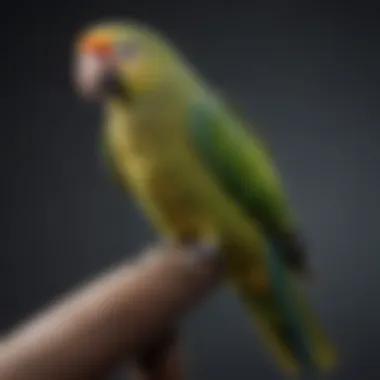
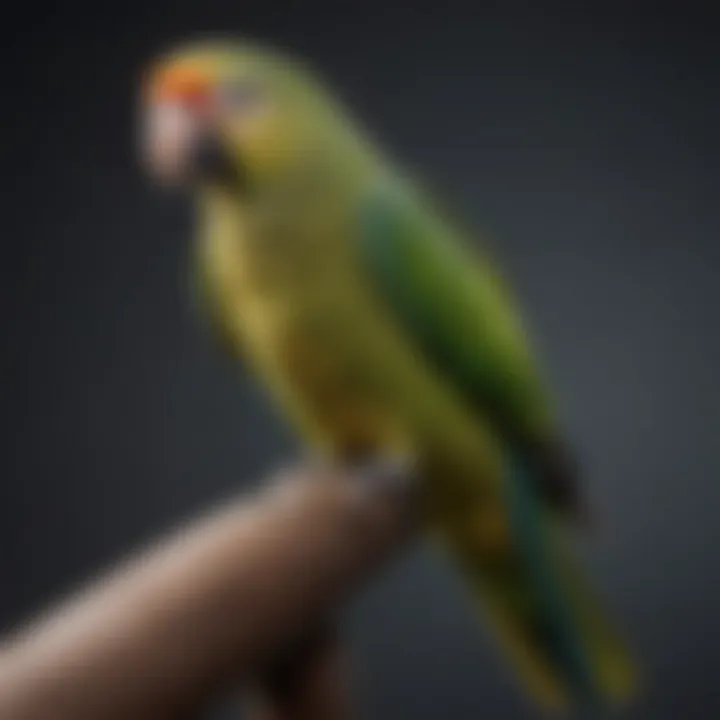
Intro
BirdTricks has emerged as a vital resource for Amazon parrot owners who seek to enhance their relationship with these intelligent and social birds. Understanding the unique needs of these parrots is crucial for fostering a harmonious environment. This article explores different facets of bird care, training, nutrition, and overall well-being, making it an essential guide for both newcomers and seasoned bird enthusiasts.
Care Tips
Daily Care Routines
Caring for an Amazon parrot requires a consistent daily routine. This includes a balanced mixture of feeding, social interaction, and mental stimulation. Begin each day by providing fresh food and water. Monitor the quantity to avoid waste while ensuring that your bird has enough nutrition. Allocate time for out-of-cage activities as well, which helps strengthen your bond.
Cage Setup and Maintenance
A well-structured cage is important for the health of your parrot. Choose an appropriately sized cage, allowing ample space for movement and play. Include perches of varying diameters to promote foot health and stimulate exercise. Regular cage cleaning is essential. Remove waste and uneaten food daily to prevent disease.
Hygiene and Cleaning Practices
Maintaining hygiene is paramount. Use bird-safe cleaning products. Clean the cage bars, trays, and toys weekly. Disinfect the cage using a vinegar solution to kill bacteria safely. Most importantly, always wash your hands before and after handling your bird.
Seasonal Care Adjustments
Different seasons demand varied care practices. In summer, ensure your home is cool enough as Amazon parrots can be sensitive to heat. In winter, monitor humidity levels; dry air can affect their respiratory health. Introduce seasonal toys or fluctuations in diet to keep your bird engaged.
Behavioral Insights
Understanding Bird Body Language
Amazon parrots communicate through body language. Observing their posture and vocalizations can reveal their emotions. For instance, fluffed feathers can indicate stress, while a relaxed stance often reflects comfort. Learning this subtleties aids in anticipating needs and preventing issues.
Common Behavioral Issues and Solutions
Behavioral problems such as excessive screaming or biting are common among Amazon parrots. These issues typically arise from boredom or lack of social interaction. Solutions include increasing playtime, introducing new toys, or engaging in interactive training sessions.
Positive Reinforcement Techniques
Using positive reinforcement in training can be highly effective. Reward your parrot with treats, praise, or affection when they successfully follow commands. This method strengthens the human-avian bond and encourages desired behaviors.
Social Interaction Needs
Amazon parrots are social creatures and thrive on interaction. Aim for at least 2-3 hours of quality time with your bird daily. Consider adding another bird for companionship, but ensure proper introductions and compatibility.
Nutrition Guides
Essential Diet Components
An optimal diet for an Amazon parrot must include high-quality pellets, fresh fruits, and vegetables. Pellets should form the basis of their diet, supplemented with nuts and seeds in moderation. A diverse diet promotes health and vitality.
Safe and Toxic Foods
Educate yourself on safe and toxic foods. Safe options include apple, carrot, and dark leafy greens. Foods to avoid include chocolate, avocado, and caffeine. Understanding these can prevent potential health hazards.
Supplements and Treats
Consider adding calcium and vitamin supplements to your parrot's diet, particularly if they are older or not getting enough sunlight. Use treats sparingly and ensure they are healthy, such as small pieces of fruit or nuts.
Feeding Strategies for Different Species
Different species of Amazon parrots may have specific nutritional needs. Consult resources like the Avian Medicine for tailored dietary strategies that cater to your parrot’s species.
Wellness and Health
Routine Health Checkups
Regular veterinary checkups are essential for your parrot’s health. Routine exams help catch potential issues early. Develop a relationship with an avian vet who understands Amazon parrot care.
Identifying Symptoms of Illness
Knowing the signs of illness is crucial. Common symptoms to observe include changes in appetite, lethargy, or feather plucking. Immediate veterinary consultation is advisable if any abnormal behavior occurs.
Preventative Care and Vaccinations
Preventative health measures, including vaccinations, are key to maintaining your bird’s health. Research the necessary vaccinations for Amazon parrots, and schedule them with your vet.
Mental and Emotional Well-being
Mental well-being is as vital as physical health. Enrichment activities, such as puzzle toys, and social interaction can combat boredom. Ensure your parrot has an environment that encourages exploration and activity.
Enriching Activities
Toys and Playtime Ideas
Invest in appropriate toys that pique curiosity. Rotate toys regularly to maintain interest. For physical activity, provide climbing structures and hanging ropes.
Training and Tricks
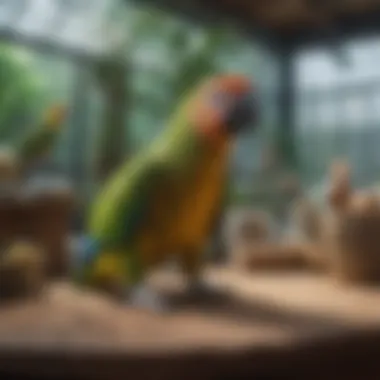
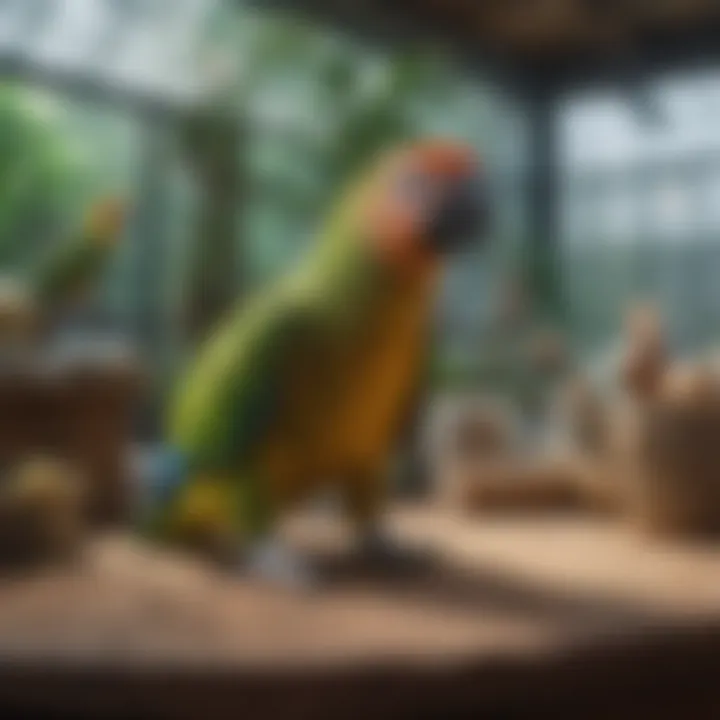
Training is both fun and mentally stimulating. Teaching simple tricks builds confidence and strengthens communication. Short, daily training sessions work best to avoid overwhelming your bird.
Outdoor Activities and Interaction
Monitor your bird while outdoors. Fresh air and new sights can enrich their lives. Use harnesses specifically designed for birds to ensure safety during outings.
DIY Projects for Mental Stimulation
Creating DIY projects can offer significant enrichment. Craft simple toys using safe materials. Challenge your parrot's intelligence with games that require them to unlock treats, fostering interaction and engagement.
Prologue to BirdTricks
Understanding how to care for an Amazon parrot requires both knowledge and commitment. This section, dedicated to BirdTricks, aims to establish a foundation for pet owners who wish to enhance their relationships with these intelligent birds. BirdTricks offers valuable training resources and insights tailored specifically for Amazon parrot owners, promoting harmonious interactions and enriching experiences.
The significance of BirdTricks lies not just in its training techniques but also in its ability to connect owners with their birds’ natural behaviors. By addressing the specific needs of Amazon parrots, BirdTricks provides a roadmap for effective communication that can lead to a deeper bond.
When studying this topic, it is essential to recognize the benefits of structured training and behavioral understanding. Effective training can mitigate common issues such as aggression or anxiety, ensuring that both the bird and owner lead fulfilling lives together. Additionally, BirdTricks aligns the goals of pet owners with the overall well-being of their pets, fostering an atmosphere that is both educational and supportive.
In the following sections, we will explore the scientific understanding of Amazon parrots, the mission behind BirdTricks, and the various aspects of training that will be discussed throughout the article. This will help clarify how to best implement these strategies in everyday situations to cultivate a nurturing environment.
Understanding Amazon Parrots
Amazon parrots are known for their remarkable intelligence and vibrant personalities. These birds can mimic human speech, engage in complex play, and form deep emotional bonds with their owners. Understanding the unique traits and needs of Amazon parrots is crucial for anyone considering adopting one.
The interactions between owners and Amazon parrots can be profoundly rewarding. However, without comprehensive knowledge of the species, misunderstandings and challenges can arise. Recognizing behaviors such as feather plucking or excessive screeching will allow owners to address underlying issues effectively. This section emphasizes that a well-informed approach is vital to fostering a positive relationship with these charming birds.
Haaving a complete view of an Amazon parrot’s needs also involves acknowledging their social nature. Providing opportunities for socialization, mental stimulation, and physical exercise can all contribute to a happy, healthy bird. BirdTricks taps into these aspects, guiding owners on how to create environments that enrich their pet's lives.
The Mission of BirdTricks
The mission of BirdTricks is to enhance the bonds between parrot owners and their birds by providing accessible, research-based training and care resources. It aims to transform the often-challenging experience of bird ownership into a fulfilling journey characterized by mutual understanding and respect.
BirdTricks focuses on practical strategies to better understand and train Amazon parrots. This includes step-by-step training guides and behavioral insights that cater to various levels of experience. The aim is to empower owners to take an active role in their bird's development.
One key objective of BirdTricks is to equip owners with tools to tackle common behavioral issues. Strategies like positive reinforcement and clear communication can lead to reduced stress for both the bird and the owner. The organization emphasizes the necessity of patience and consistency in training, which ultimately contributes to the bird’s well-being.
By focusing on clear, science-driven methodologies and a strong community ethos, BirdTricks aspires to usher in an era of enlightened bird ownership. This mission is not just about practical training; it encompasses a profound understanding of what it means to share a life with an Amazon parrot.
The Importance of Training
Training Amazon parrots is not just a task; it is a vital aspect of their care and wellbeing. Training fosters a stronger bond between the bird and the owner. It can significantly reduce behavioral issues and enhance the overall quality of life for both. Proper training addresses the natural instincts of parrots and helps to channel their energy into positive behaviors. This mutual communication sets the tone for an enriched environment where both the bird and the owner can thrive.
Why Training Matters
Training matters for various reasons. First, it enables Amazon parrots to understand expectations. These birds are intelligent creatures, and without proper guidance, they may develop undesirable behaviors. Secondly, training can help in managing stress levels. An untrained parrot may feel anxious and insecure. Training provides structure and predictability, which eases their anxiety.
Moreover, trained birds often exhibit fewer aggressive behaviors. This is because they learn how to interact appropriately with their owners and surroundings. Owners, in turn, feel more confident in their ability to manage and care for their parrots. Training leads to better social interaction with other pets and humans too. Understanding behavioral cues is also critical.
Types of Training Techniques
There are several effective training techniques that can be applied to Amazon parrots. Each method has its unique characteristics and can be chosen based on the bird's personality and the owner’s preferences. Here are some popular types:
Positive Reinforcement
Positive reinforcement is one of the most widely accepted training methods in avian care. This technique involves rewarding the bird for displaying desired behaviors. The reward can be a treat, praise, or attention. The key characteristic of this method is its focus on encouragement rather than punishment.
This approach is popular because it builds trust between the parrot and the owner. The unique feature of positive reinforcement is its simplicity. It effectively encourages repeat behaviors without causing fear or stress to the bird. However, one should be cautious not to overindulge the bird with too many treats, which can lead to obesity.
Clicker Training
Clicker training is another effective technique for training Amazon parrots. This method uses a small device that makes a clicking sound to mark correct behaviors instantly. The strong characteristic of clicker training is its precision. The bird quickly learns that the click sound signifies a job well done.
This technique is beneficial because it reinforces behavior timing. Amazon parrots can often forget what they did wrong or right if the feedback is delayed. The unique feature of clicker training is its versatility. It can be combined with other training methods to enhance learning. However, it may require additional effort from the owner to maintain the clicker and ensure it is used consistently.
Target Training
Target training involves teaching the bird to touch a specific object, such as a stick, with its beak. This method is effective for gaining the bird’s attention and directing its behaviors. The key characteristic of target training is its interactive nature, making it a fun experience for both bird and owner.
Target training’s unique feature is that it provides an outlet for the bird’s natural curiosity. It allows for more complex behaviors to be taught over time. One advantage of this method is its flexibility; it can be adapted for various purposes, such as handling, vet visits, and travel. However, it requires patience and consistency to achieve successful outcomes.
Training is an ongoing process. It’s essential to be patient and understanding as the bird learns and grows.
Behavioral Insights for Amazon Parrots
Understanding the behavioral intricacies of Amazon parrots is crucial in ensuring a harmonious living environment. These birds are intelligent and social creatures that express their feelings and needs through various behaviors. By increasing awareness of their behavioral traits, bird owners can foster a deeper connection with their pets and enhance their overall well-being.
Understanding Bird Behavior
Common Behavioral Traits
Amazon parrots exhibit a range of common behavioral traits that reflect their personality and emotional state. These traits include vocalization, playfulness, and social interaction. Recognizing these behaviors allows owners to meet their parrot’s needs more effectively. For instance, vocalization serves not only as a means of communication but also as an expression of their mood.
A significant characteristic of these birds is their high level of curiosity. This trait encourages exploration and learning. This aspect contributes to their mental stimulation and overall happiness. However, it also necessitates careful supervision and a safe environment to prevent accidents. Identifying these common traits is an essential step toward effective care and training.


Reading Body Language
The body language of Amazon parrots is intricate and often communicates more than their vocalizations. By learning to interpret body language, owners can gain insights into their bird’s emotions and intentions. Key indicators include tail feather position, wing posture, and eye movements. For example, a puffed-up appearance can indicate excitement or fear, while an open beak might suggest aggression or discomfort.
Understanding body language is beneficial as it allows for proactive responses to a parrot's needs. An owner who can read their bird’s cues can provide timely interventions and support. This unique aspect of communication fosters a stronger bond and minimizes behavioral issues rooted in misunderstanding.
Signs of Stress and Anxiety
Recognizing signs of stress and anxiety in Amazon parrots is vital for their well-being. Common indicators include excessive vocalization, feather plucking, and changes in eating habits. These signs often signal that the bird feels threatened or uncomfortable in its environment.
A notable characteristic of stress-related behaviors is their variability; different birds may react differently to the same stimuli. Understanding these signs is advantageous for early intervention. Addressing stress promptly can lead to a healthier, happier bird, while neglecting these signs can result in severe behavioral problems down the line.
Social Interaction Needs
Social interaction is a fundamental requirement for Amazon parrots. These birds thrive in environments where they can engage with their owners or other birds. Their social nature means that neglecting their interaction needs can lead to loneliness and depression. It is essential to provide ample opportunities for interaction to keep them mentally and emotionally healthy.
Conclusion: Observing and understanding behavioral insights not only leads to better care but also strengthens the bond between owner and parrot. Such knowledge empowers owners to make informed decisions, greatly enhancing the Amazon parrot experience.
Nutritional Requirements for Amazon Parrots
Nutrition plays a crucial role in the overall health and well-being of Amazon parrots. Proper dietary practices are vital for supporting their immune systems and enhancing their quality of life. This section highlights key components of a suitable diet, addressing essential nutrients and common dietary pitfalls that owners should avoid. A deeper understanding of these nutritional requirements can lead to longer and healthier lives for these vibrant birds.
Essential Nutrients
Vitamins and Minerals
Vitamins and minerals are foundational to the health of Amazon parrots. They contribute to numerous bodily functions, from immune support to bone health. For instance, vitamin A is crucial for maintaining healthy skin and vision. Meanwhile, calcium is important for strong bones and proper muscle function.
Key characteristic: Vitamins and minerals are needed in minute quantities but have significant effects on health. They are a worthwhile choice because deficiencies can lead to severe health problems, including metabolic bone disease.
One unique feature of these nutrients is that they usually come from varied sources, including fruits, vegetables, and specially formulated pellets. This diversity offers advantages, as it encourages a more balanced intake of different nutrients. However, over-supplementation can invite disadvantages, leading to toxicity, which is a significant concern in avian care.
Balanced Diet Components
A balanced diet for Amazon parrots is composed of various food groups, including grains, seeds, vegetables, and fruits. Each component serves a distinct purpose in meeting the bird's nutritional needs. For example, fresh vegetables and fruits provide hydration and essential vitamins. Similarly, grains offer energy and help maintain digestive health.
Key characteristic: A balanced diet prevents nutritional deficiencies and supports overall vitality. It is a favorable choice as it mimics the natural diets found in their wild habitats.
The unique feature of balanced diet components lies in their ability to promote variety, preventing boredom and encouraging natural foraging behaviors. One advantage is how it fosters longevity. On the downside, not all bird owners may be equipped to provide truly balanced diets, which can lead to less optimal nutrition.
Common Dietary Mistakes
Amazon parrot owners often make dietary mistakes that can adversely affect their birds. The most common errors include feeding too many seeds or relying excessively on pellets without adding fresh produce.
It is important to recognize that a seed-only diet is insufficient. Seeds lack the vitamins, minerals, and fiber needed for overall health.
Moreover, avoiding human food is another mistake often made. Some human foods are toxic to birds, such as chocolates or avocado. Awareness of these hazards is essential for responsible ownership.
Creating an Enriching Environment
Creating an enriching environment for Amazon parrots is fundamental for their overall well-being. This topic is essential as it directly affects the bird's mental stimulation, physical health, and emotional happiness. A well-structured environment caters not only to the basic needs of the parrot but also encourages natural behaviors and improves the bond between the bird and its owner.
Several elements contribute to an enriching atmosphere. These include appropriate cage setup, safe toys, activities that stimulate engagement, and opportunities for social interaction. The benefits of an enriched environment are vast; it can reduce boredom and the risk of behavioral issues such as excessive screaming or feather plucking. Additionally, a stimulating environment keeps the bird active, aiding its physical health.
When considering an enriched environment, one must keep in mind the individual personality and interests of their Amazon parrot. Some birds may prefer climbing structures, while others might engage more with foraging toys or mirrors. Observing the behaviors and preferences of one's bird is key to successfully tailoring an enriching environment that meets its specific needs.
Cage Setup Recommendations
The cage is the primary space where an Amazon parrot will spend most of its time. Therefore, setting it up correctly is crucial. The size of the cage should be adequate to allow for movement and exercise. A cage that is too small can restrict the bird's natural behaviors.
Consider these recommendations for cage setup:
- Space: The minimum recommended cage dimensions for an Amazon parrot are generally 36" x 24" x 36", ensuring plenty of room to move.
- Perches: Use various perches made from different materials and sizes to promote foot health. Make sure to place perches at different heights to create levels.
- Hiding Spots: Include areas where the bird can retreat for privacy or security. This can help reduce stress and anxiety.
- Food and Water Stations: Place food and water bowls in easily accessible areas of the cage, ensuring they are clean and refilled regularly.
- Ventilation and Lighting: Ensure proper air flow and natural light in the cage area. Avoid direct sunlight and drafts, which could pose health risks.
Toys and Activities for Stimulus
Toys and activities play an important role in enriching the life of an Amazon parrot. They help prevent boredom and serve as a source of mental stimulation. Parrots are intelligent creatures that require engagement to thrive.
Consider incorporating the following types of toys and activities into your parrot's environment:
- Foraging Toys: These toys encourage birds to seek food, mimicking natural foraging behavior. Hiding treats in puzzle toys can also stimulate problem-solving skills.
- Chewing Toys: Safe, wood-based toys allow parrots to satisfy their instinct to chew. Common materials include untreated pine or manzanita wood.
- Interactive Toys: Toys that can be manipulated or moved will engage your Amazon parrot and increase its curiosity. Toys that make sounds, activate lights, or require interaction can also capture attention.
- Regular Rotation: Change toys periodically to maintain your parrot's interest. This helps keep the environment fresh and exciting.
- Social Activities: While solitary play is important, social interaction with you or other birds can add a significant benefit to their enrichment. Short training sessions or casual communication can strengthen your bond.
"An enriched environment is essential for keeping an Amazon parrot healthy and happy. It directly influences their quality of life."
Integrating BirdTricks Techniques
BirdTricks provides a structured approach to enhance the relationship between parrot owners and their Amazon parrots. The integration of BirdTricks techniques plays a crucial role in developing a harmonious environment for both the bird and the owner. In short, it bridges the gap between understanding avian needs and delivering effective training. The methods emphasized by BirdTricks support better communication, which is fundamental in forming an enduring bond. Moreover, a well-implemented training technique helps mitigate behavioral problems, leading to a more fulfilling experience for both bird and owner.
An important consideration when integrating these techniques is consistency. Training must be practiced regularly to yield positive results. Each technique is designed to gradually build the bird’s confidence and knowledge. Following these established strategies can lead to numerous benefits, including enhanced social interaction, improved mental stimulation, and greater overall well-being of the bird.
Step-by-Step Training Guide
To effectively train your Amazon parrot using BirdTricks methods, it is essential to follow a structured guide. The process involves several steps that are essential for success:
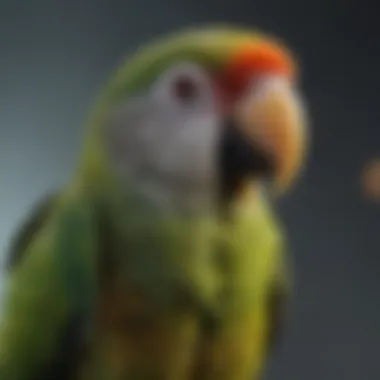
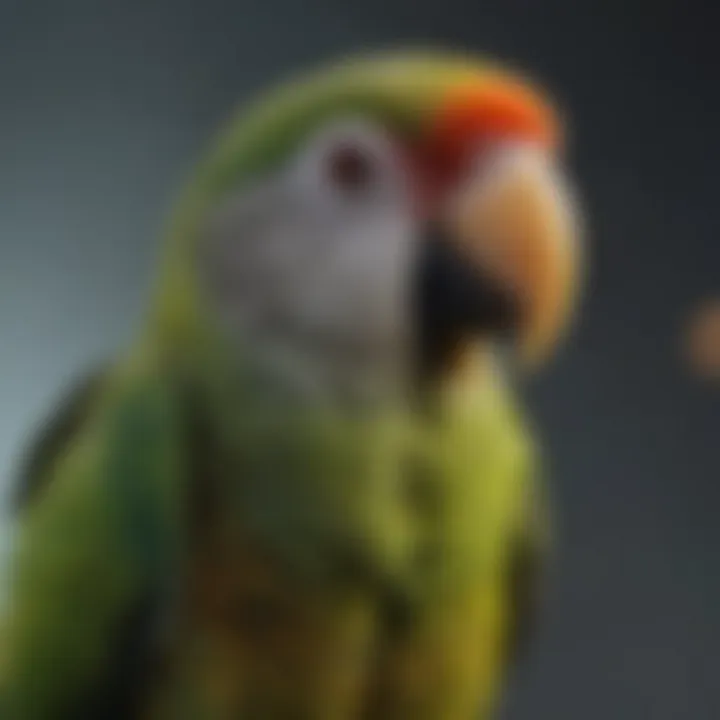
- Preparation: Gather all necessary tools and materials. This may include treats, toys, and time to engage.
- Understanding Your Bird: Spend time observing behavior patterns and preferences. This insight aids in tailoring the training methods.
- Selecting a Technique: Choose one of the BirdTricks techniques, such as positive reinforcement or clicker training, that best suits your bird’s personality.
- Starting with Simple Commands: Begin with basic commands or tricks, which are easier for the bird to grasp. Gradually introduce more complex tasks as confidence builds.
- Consistent Practice: Regular short training sessions are more effective than sporadic long ones. Aim for 5 to 10 minutes daily.
- Positive Feedback: Provide immediate praise and rewards upon successful completion of tasks. This reinforces desired behavior.
- Monitor and Adjust: Observe how the bird responds and adjust accordingly. The training should remain fun and engaging.
These steps provide a clear framework for implementing BirdTricks techniques effectively.
Monitoring Progress
Monitoring progress is an integral part of the training process. It ensures that training sessions are effective and allows an owner to make necessary adjustments. Here are some key methods for tracking the progress of your Amazon parrot:
- Behavioral Observations: Keep a journal noting any changes in behavior, interaction, or milestones achieved. This can highlight successes or areas needing improvement.
- Training Milestones: Set specific goals for your bird, such as completing a trick or responding to a command. Celebrate small victories along the way to maintain motivation.
- Regular Assessments: Conduct regular assessments to evaluate skill development and adherence to commands. This can guide future training efforts.
Consistent monitoring can help you to quickly identify any setbacks or challenges in training, fostering a more adaptive training regimen.
By clearly defining and following a progression plan, owners can better support their birds and foster an environment conducive to learning. Integrating BirdTricks techniques provides a solid foundation to enhance the Amazon parrot experience.
Common Challenges and Solutions
When caring for Amazon parrots, owners face numerous challenges that can affect both the bird's well-being and their relationship with the bird. Understanding these challenges is crucial. It allows for the development of effective solutions that promote a harmonious environment for both parrot and owner. This section explores common behavioral issues and health concerns, along with practical solutions that can lead to better care practices.
Behavioral Issues
Training Setbacks
Training setbacks can be frustrating. These occur when a parrot does not progress as expected during training sessions. This may stem from various reasons including poor communication, lack of consistency, or the parrot's own temperament. Key characteristic of training setbacks is that they often lead to discouragement for the owner. However, recognizing these setbacks can also be an opportunity for growth. It highlights the need for patience and adjustment of training methods.
A beneficial approach for overcoming these setbacks includes re-evaluating the training plan. Being aware of each bird's learning pace can lead to a more tailored approach that suits the individual. Training setbacks remind trainers to adapt strategies when necessary, making them an invaluable part of the training journey.
Addressing Aggression
Aggression in Amazon parrots is a significant concern. Addressing this behavior involves understanding the root causes, which can include fear, territory disputes, or frustration. The key characteristic of addressing aggression is its focus on communication and environment adjustments. It is beneficial for both the parrot and owner as it fosters trust and reduces incidents of aggression over time.
One unique feature of addressing aggression is the approach of positive reinforcement. This involves rewarding calm and non-aggressive behaviors rather than punishing aggressive actions. The advantage here is substantial; it builds a more trusting relationship between the parrot and owner, which can reduce aggressive incidents in the future. However, it requires ongoing commitment and awareness from the owner.
Health Concerns
Preventive Care
Preventive care is paramount when it comes to maintaining an Amazon parrot's health. It includes regular vet visits, appropriate diet, and environmental checks. The key characteristic of preventive care is its proactive approach to health management. This strategy is popular in avian care because it can significantly reduce the risks of severe health issues in the long run.
A unique feature of preventive care is the use of health checklists that help owners monitor their bird’s condition consistently. The advantages of this are clear. It allows for timely intervention, leading to better health outcomes and extended lifespans for the birds. However, attention to detail is necessary, as neglecting even minor changes in behavior can lead to health declines.
Signs of Illness
Recognizing signs of illness is essential for timely treatment. Parrots are skilled at masking illnesses until they become serious. Key characteristics of signs of illness include changes in behavior, eating habits, or vocalizations. Awareness of these signs can be life-saving, making them an essential element in this article.
The unique feature of identifying signs of illness is the proactive stance it puts owners in. By understanding what to look for, owners can act quickly. This little effort can have significant advantages. For example, early diagnosis often results in more effective treatments, reducing both the bird’s suffering and the financial burden on the owners. The downside is that many owners may overlook subtle changes, delaying necessary care.
Awareness and education are necessary tools to deal with challenges in caring for Amazon parrots. By addressing behavioral issues and health concerns effectively, owners can foster a nurturing and safe environment.
The Role of the Community
The role of the community in the realm of Amazon parrot care is quite significant. Engaging with others who share a passion for these birds can enhance learning and improve overall experiences for owners and their pets. The community offers a space for discussions, sharing knowledge, and addressing common challenges that arise during ownership. Having access to collective experiences can dispel myths and provide practical advice that can be beneficial for both novice and seasoned bird owners.
Interacting within a community creates a support network that alleviates the feeling of isolation some pet owners might face. It can be reassuring to know that others are facing similar challenges, whether it is regarding training techniques or health concerns affecting their parrots. This connection fosters a sense of belonging that contributes positively not only to the owners but also to the well-being of their birds.
Online Forums and Resources
Online platforms serve as vital resources for bird owners looking to expand their knowledge and connect with others. Forums like Reddit and specialized websites provide a wealth of information. Members share their learned experiences, including training tips and bird behavior insights, paving a smoother path for those who are new to bird ownership.
In these forums, the exchange of ideas and solutions fosters a collaborative environment. Owners can post their challenges and receive feedback from other users who have dealt with similar situations. These discussions help to normalize difficulties involved in parrot care and offer new perspectives on how to handle them effectively.
Important online forums include:
- Reddit: A platform where users gather for discussions and advice specific to Amazon parrots.
- Facebook groups: Communities dedicated to bird owners can often become a space for support and exchange.
Connecting with Other Bird Owners
Establishing connections with other bird owners offers numerous benefits. Not only does it provide opportunities for social interactions, but it also leads to knowledge sharing and potential partnerships. Local meet-ups can help owners learn through real-life demonstrations and hands-on experiences.
Moreover, meeting other bird enthusiasts can inspire motivation and creativity in terms of training and care techniques. Exchanging ideas about toys, dietary practices, and behavioral insights can elevate the overall experience for both bird owners and their pets, resulting in a more satisfying bond.
Here are some tips for connecting with fellow bird owners:
- Attend local bird clubs or events: These settings provide opportunities to meet others who share the same interests.
- Join social media entities: Engage with communities specifically focused on Amazon parrots.
- Participate in avian conventions: These events often feature educational sessions and the chance to network with experienced bird keepers.
Culmination
The conclusion of this article serves as a critical synthesis of the various discussed elements. Highlighting key aspects of care for Amazon parrots, it brings forth the notion of commitment that every owner must embrace. This responsibility extends beyond feeding and shelter; it encapsulates an understanding of behavioral needs, training, and social interaction.
The Lifelong Commitment to Care
Owning an Amazon parrot requires a sincere, long-term dedication. This is not just about having a pet; it is about forming a lasting bond. An Amazon parrot can live for decades, making it essential to consider the implications of this lifelong relationship. Here are several important elements to keep in mind:
- Emotional Connection: Building trust with your parrot takes time. This involves daily interaction and the constant reinforcement of positive behaviors.
- Training and Enrichment: Implementing techniques from BirdTricks ensures that your parrot stays engaged and mentally stimulated. A bored bird can develop behavioral issues, so consistent training is vital.
"A well-trained parrot is often a happy parrot, and a happy parrot contributes to a satisfying home environment."
- Health Maintenance: Regular veterinary check-ups are non-negotiable. Parrots are adept at hiding illness, so observing their behavior closely is crucial. Nutritional support cannot be overlooked either; providing a balanced diet contributes significantly to an ambient state of health.
- Community Support: Connecting with other parrot owners can provide valuable insights and emotional support. Online forums, such as those on Reddit, allow you to share experiences, seek advice, and celebrate milestones in your parrot ownership journey.
In summary, the commitment to care involves multiple layers: education, patience, and ongoing dedication. Understanding these elements ensures that your relationship with your Amazon parrot translates into a fulfilling experience for both of you.















